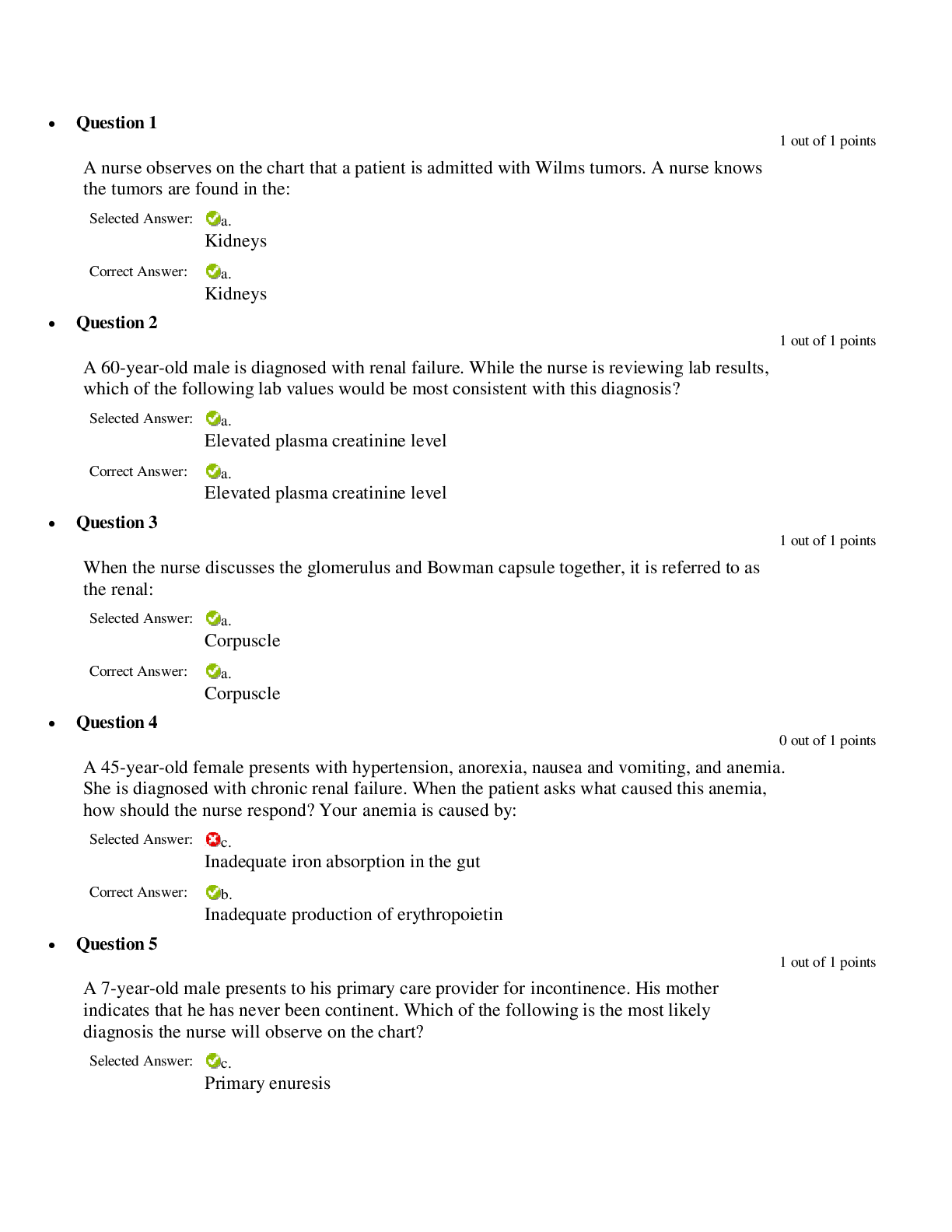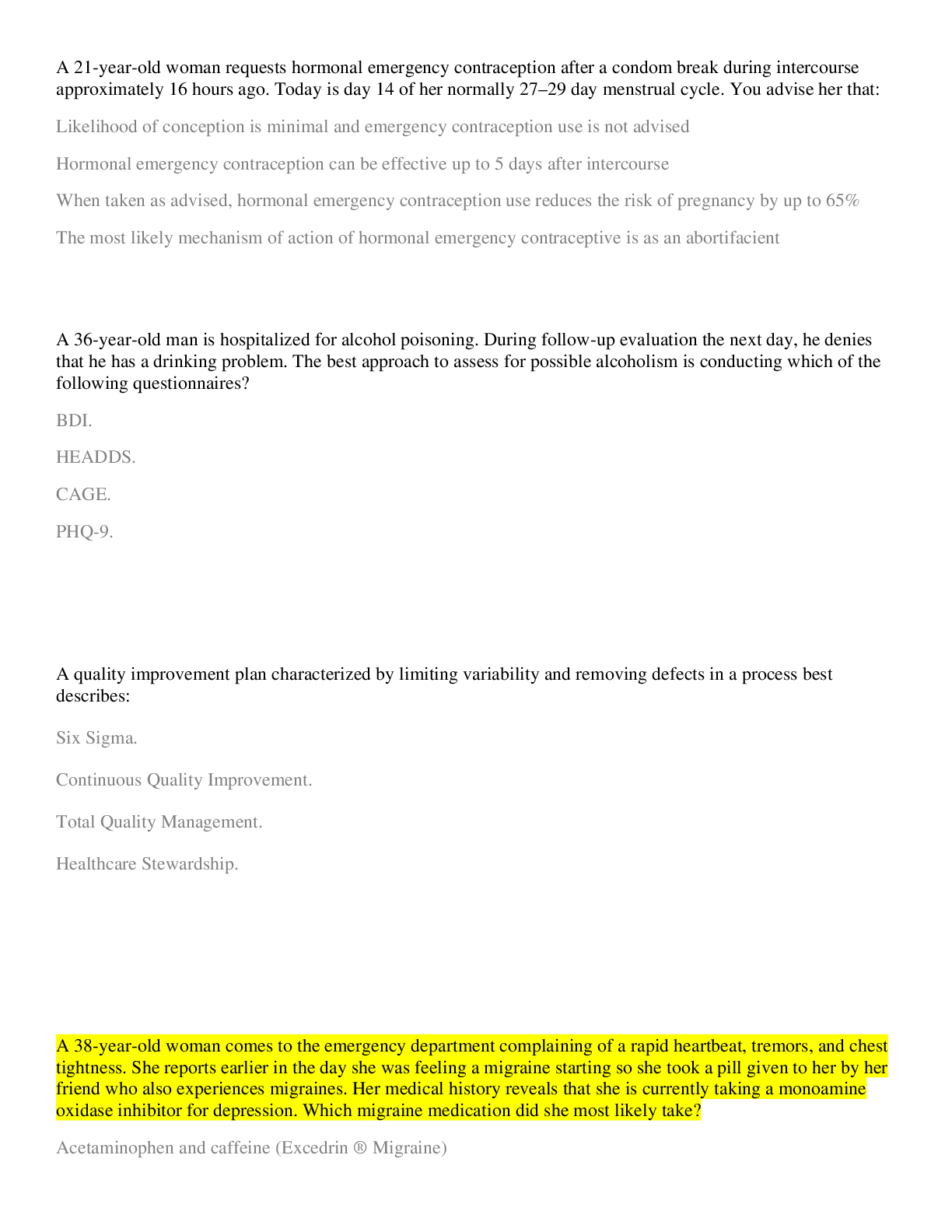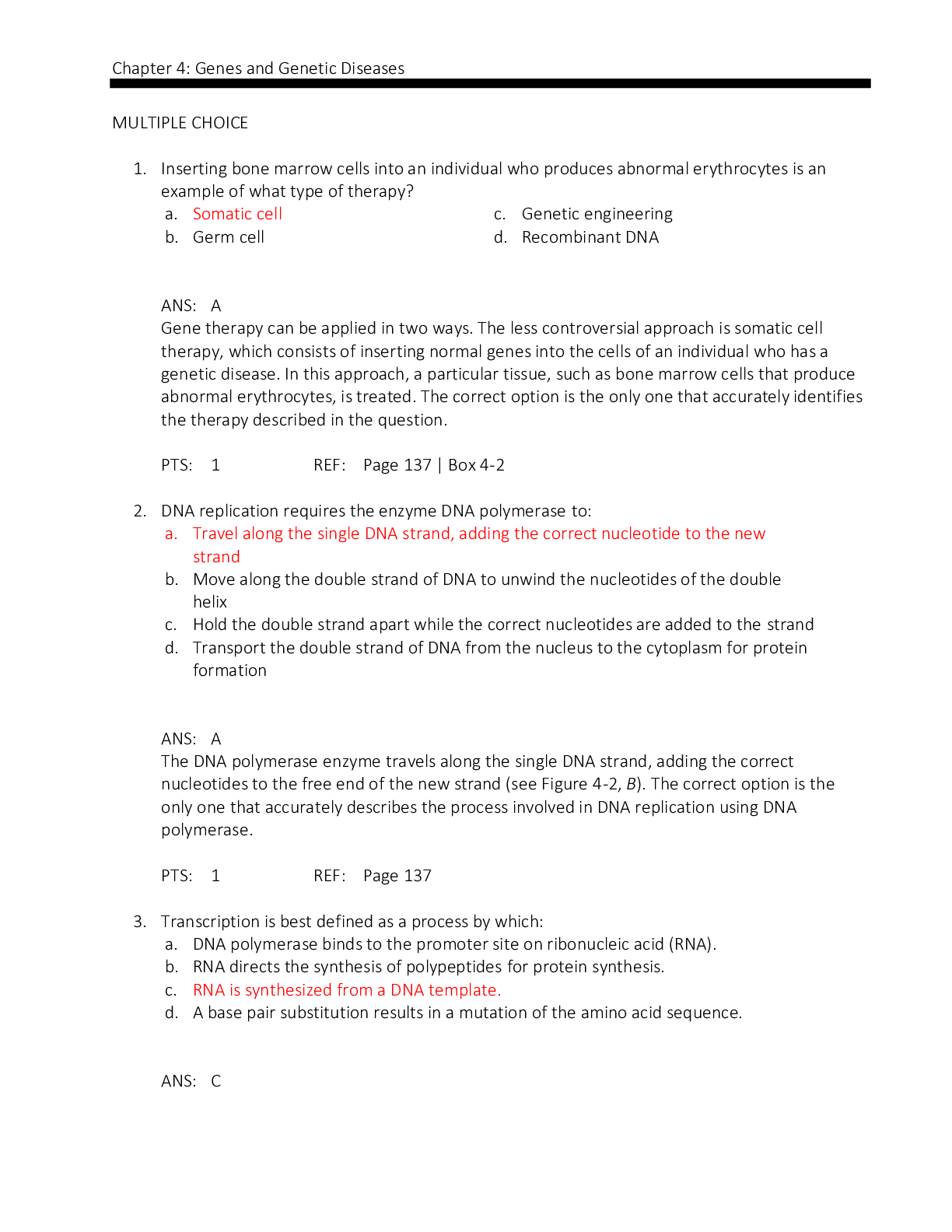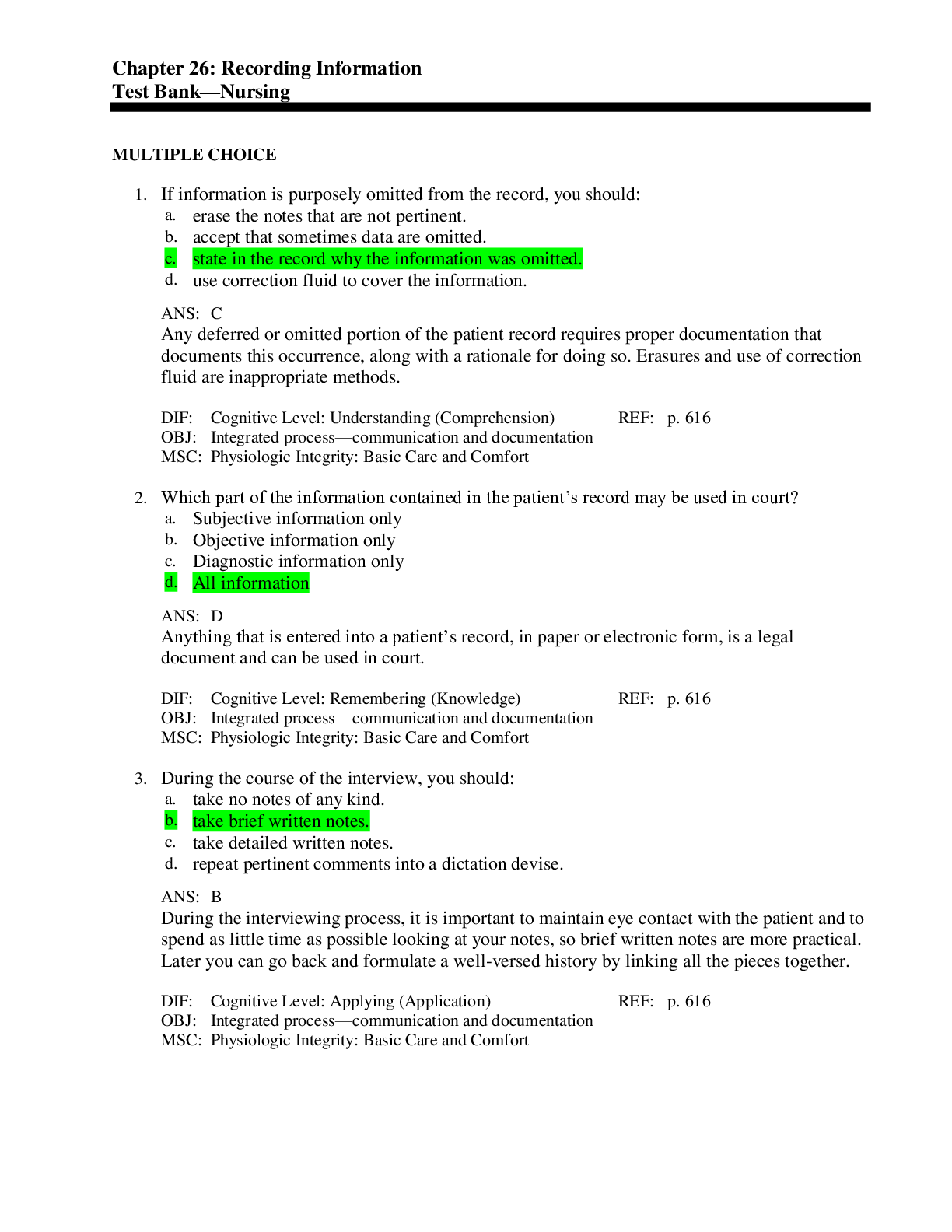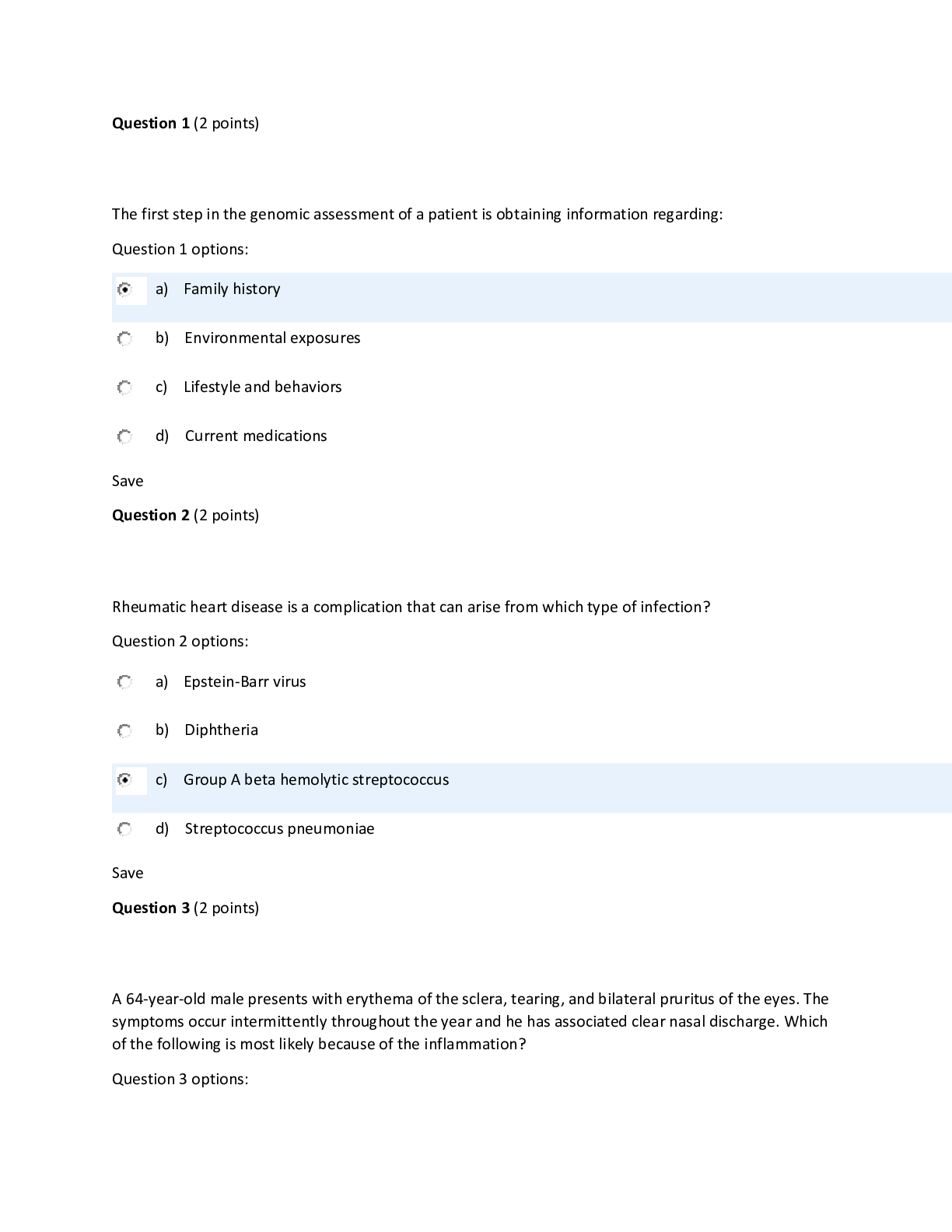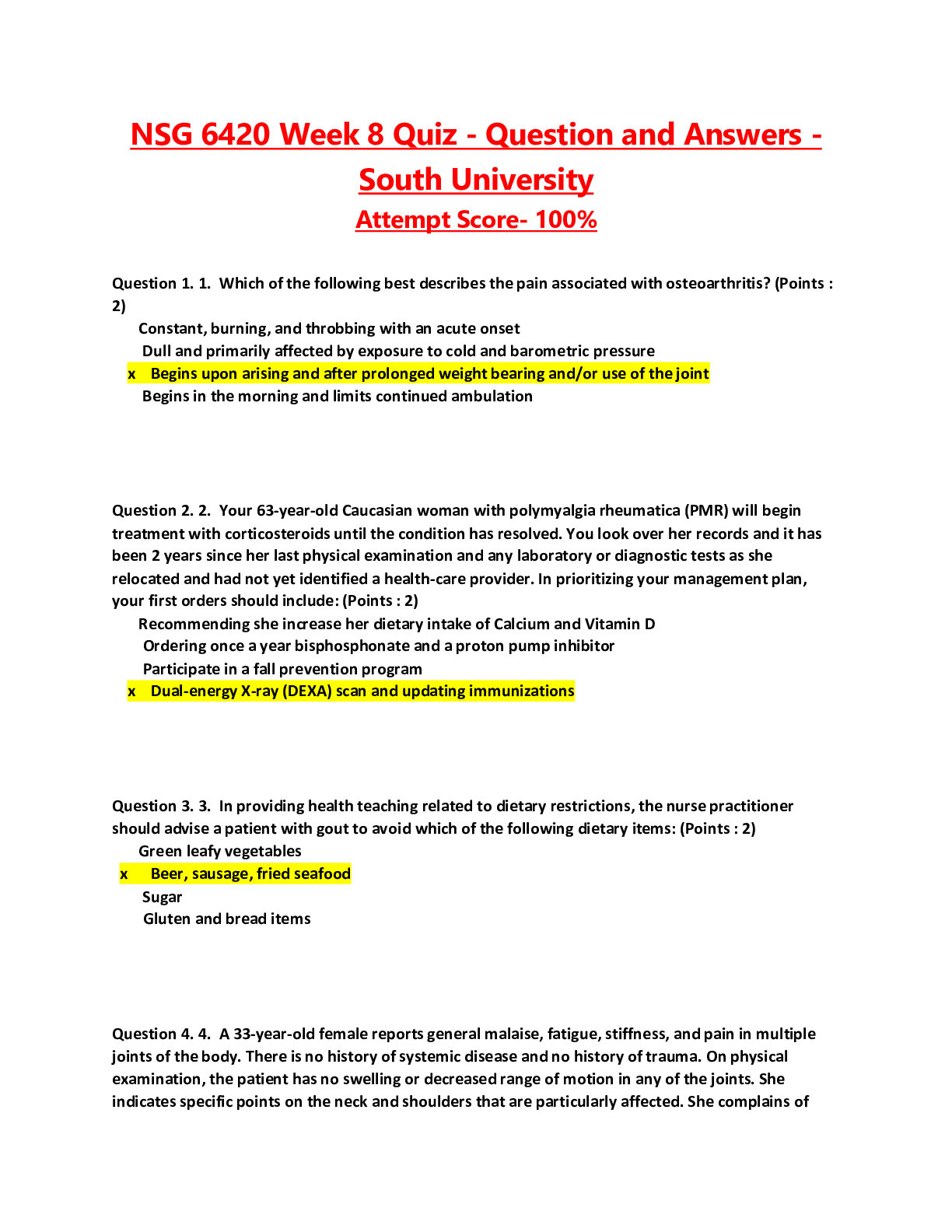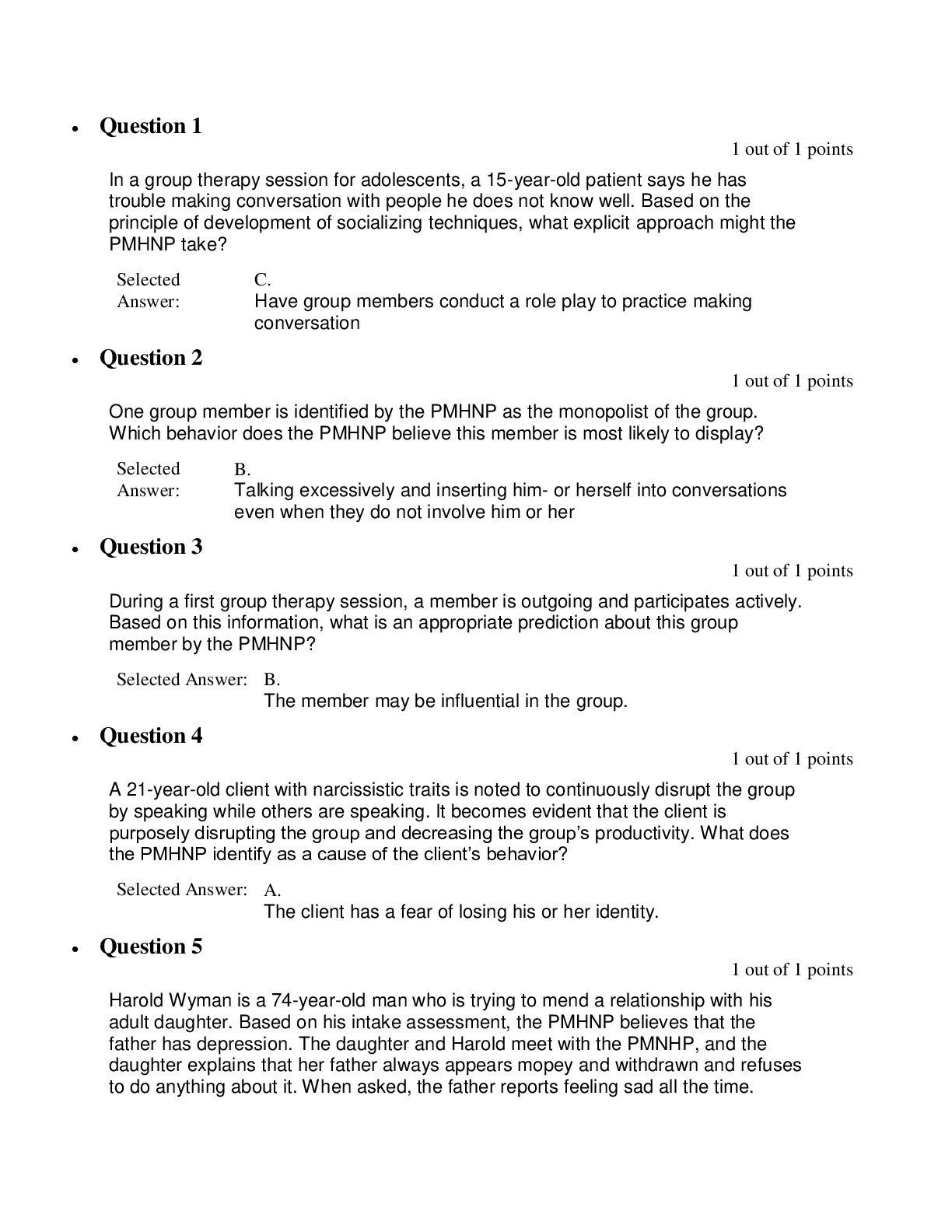ANCC Practice Question and Answers_ Latest,100% CORRECT
Document Content and Description Below
ANCC Practice Question and Answers_ Latest 1. When discharging an 85-year-old patient with stasis dermatitis, the adult-gerontology acute care nurse practitioner includes instructions to: keep leg... s elevated while seated. maintain systolic blood pressure greater than 120 mmHg. soak legs in warm water daily. wear compression stockings of 65 mmHg below the knee. STASIS DERMATITIS AFFECTS PRIMARILY THE LOWER LEGS AND ANKLES SECONDARY TO CHRONIC EDEMA (FROM PAD – PREVIOUSLY KNOWN AS PERIPHERAL VASCULAR DISEASE) KNOWN AS ATROPHIC CHANGES – SHINY AND HYPERPIGMENTED ANKLES THAT ARE HAIRLESS AND COOL TO TOUCH WORSENING PAIN ON AMBULATION (INTERMITTENT CLAUDICATION) THAT IS INSTANTLY RELIEVED BY REST ABI SCORE EQUAL OR LESS THAN 0.9 2. A young female patient arrives at the emergency department with a vaginal discharge. After performing a pelvic examination, the adult-gerontology acute care nurse practitioner documents which finding? Cervical motion tenderness. Positive bowel sounds. Pink vaginal mucosa. Positive rectal tone. 3. A patient has hyperactive reflexes of the lower extremities. The adult-gerontology acute care nurse practitioner assesses for ankle clonus by: applying a low-pitched tuning fork firmly to the lateral malleolus. sharply dorsiflexing and maintaining the foot in this position, while supporting the knee. striking the Achilles tendon with the percussion hammer after flexing the leg at the knee and rotating it externally. stroking the lateral aspect of the sole with the sharp end of the percussion hammer from the heel to the ball of the foot. CLNOUS IS A SERIES OF INVOLUNTARY, RHYTHMIC, MUSCULAR CONTRACTION AND RELAXATIONS. IT MAY BE CAUSED BY INTERRUPTION OF THE UPPER MOTOR NEURON FIBERS SUCH AS STROKE, MULTIPLE SCLEROSIS, OR METABOLIC ALTERACTIONS (IN SEVERE HEPATIC FAILURE OR SEROTONIN SYNDROME) 4. A patient with a history of heart failure arrives at the emergency department exhibiting shortness of breath and lower extremity swelling. Both of the patient’s symptoms are a result of: a decrease in plasma oncotic pressure. an increase in capillary hydrostatic pressure. an increase in capillary membrane permeability. an obstruction of lymphatic drainage. CAUSES OF EDEMA INCREASED CAPILLARY HYDROSTATIC PRESSURE – OCCURS WHEN VENOUS PRESSURES BECOME ELEVATED BY GRAVITATIONAL FORCES, VOLUME EXPANDED STATES, IN HF OR VENOUS OBSTRUCTION INCREASED CAPILLARY PERMEABILITY IS CAUSED BY PROINFLAMMATORY MEDIATORS – EX. HISTAMINE OR BRADYKININ – OR BY DAMAGE TO THE STRUCTUREAL INTEGRITY OF CAPILLARIES SO THAT THEY BECOME MORE “LEAKY” – EX. TRAUMA, BURNS AND SEVERE INFLAMMATION DECREASED PLASMA ONCOTIC PRESSURES OCCURS WITH HYPOPROTEINEMIA 5. Temporal arteritis requires immediate treatment in order to prevent: blindness in the affected eye. facial nerve palsy. transient ischemic attack. trigeminal neuralgia. 6. A 15-year-old patient with type 1 diabetes mellitus reports elevated blood glucose levels in the morning. The adult- gerontology acute care nurse practitioner determines that the patient's hyperglycemia is due to the dawn phenomenon and: increases the insulin dosage at bedtime. reduces the insulin dosage at bedtime. tests the blood glucose level at 3 a.m. every morning. tests the blood glucose level in the evening. 7. A 78-year-old male patient with heart failure develops a bacterial urinary tract infection secondary to an indwelling Foley catheter. The patient has a known history of allergy to penicillin and sulfonamides. The appropriate choice for antimicrobial therapy is: cephalexin (Keflex). ciprofloxacin (Cipro). doxycycline (Vibramycin). tetracycline (Sumycin). 8. A patient with a history of atrial fibrillation, who has maintained normal sinus rhythm with sotalol (Betapace), is hospitalized for acute pyelonephritis. The appropriate antibiotic regimen for this patient is intravenous: cefoxitin (Mefoxin). ceftriaxone (Rocephin). ciprofloxacin (Cipro). levofloxacin (Levaquin). 9. What legislation allowed nurse practitioners to be recognized Medicare providers in all geographical areas with their own provider number? Affordable Care Act. Balanced Budget Act. Civilian Health and Medical Program of the Uniformed Services. Omnibus Budget and Reconciliation Act. 10. A patient has fully recovered from septic shock due to bacteremia. The patient has been accepted to a long-term acute care facility for continuation of antibiotic therapy. The infectious disease physician has not seen the patient in two days. The adult-gerontology acute care nurse practitioner: contacts the physician to determine the appropriate duration of antibiotic therapy. notifies medical staff services that the physician has not seen the patient. waits for the physician to come see the patient. writes transfer orders for the patient. 11. A 70-year-old patient with a history of diabetes, hypertension, arthritis, and a new diagnosis of coronary artery disease, is being discharged. The adult-gerontology acute care nurse practitioner teaches the patient that the first point of contact for health care needs is the: cardiologist. endocrinologist. primary care provider. rheumatologist. 12. An 80-year-old patient has macular degeneration and is seen on the surgical unit for postoperative care after repair of a hip fracture. To prepare the patient for discharge, the adult-gerontology acute care nurse practitioner: gives illustrative pictures that instruct the patient on body alignment during activity. has the patient watch a video about surgeries and pre-operative care for hip fractures. provides the patient with an audio tape for care of hip fractures and range-of-motion activities. provides verbal reinforcement to the patient on how to keep proper body alignment following hip surgery. 13. When serving as a nurse researcher, the adult-gerontology acute care nurse practitioner is guided by which ethical principle to ensure that research participants are protected from harm or exploitation? Confidentiality. Justice. Nonmaleficence. Right to self-determination. 14. The adult-gerontology acute care nurse practitioner is asked to provide evidence to the hospital administration about the safety of nurse practitioners placing central lines. Which resource provides the strongest level of evidence? A nurse practitioner's journal editorial. A randomized control trial. A systematic review. The American Association of Colleges of Nursing's Nurse Practitioner Competencies. GOLD STANDARD FOR GATHERING RESEARCH EVIDENCE = META ANALYSIS – SYSTEMATIC REVIEW 15. What procedure does the adult-gerontology acute care nurse practitioner perform to evaluate cytology, only, in the tumor? Core biopsy Excisional biopsy – (ENTIRE) WHOLE LESION OR MASS IS REMOVED OR TESTED Fine needle biopsy - FINE NEEDLE ASPIRATIOON, SAMPLE CAN HELP MAKE DX FOR MASSES/TUMORS Incisional biopsy – (INCISED) PIECE OF TISSUE OR MASS IS REMOVED 16. A patient who has been in the intensive care unit for 17 days develops hypernatremic hyperosmolality. The patient weighs 132 lb (59.9 kg), is intubated, and is receiving mechanical ventilation. The serum osmolality is 320 mOsm/L kg H2O. Clinical signs include tachycardia and hypotension. The adult-gerontology acute care nurse practitioner's initial treatment is to: reduce serum osmolality by infusing a 5% dextrose in 0.2% sodium chloride solution. reduce serum sodium concentration by infusing a 0.45% sodium chloride solution. replenish volume by infusing a 0.9% sodium chloride solution. replenish volume by infusing a 5% dextrose in water solution. 17. A 32-year-old patient who underwent an open splenectomy for a ruptured spleen is preparing for discharge. An adult- gerontology acute care nurse practitioner reviews the potential complications with the patient. The nurse practitioner emphasizes which instruction to the patient? Continue antibiotics for 14 days. Follow up with primary care provider for vaccinations. No international travel for five years. No weight lifting restrictions. BECAUSE THE SPLEEN PLAYS A CRUCIAL ROLE IN THE BODY’S ABILITY TO FIGHT OFF BACTERIA, LIVING WITHOUT THE ORGAN MAKES YOU SUSCEPTIBLE TO DEVELOP INFECTIONS (SREP PNEUMO, NEISSERIA, H. INFLUENZA). VACCINATIONS WOULD BE IDEAL – FLU SHOT YEARLY AS WELL ADULTS USUALLY DO NOT NEED DAILY ANTIBIOTICS, UNLESS THEY BECOME SICK OR THERE IS A CHANCE, THEY COULD BECOME SICK PEOPLE WHO TRAVEL OUT OF THE COUNTRY, SHOULD CARRY ANTIBIOTICS TO TAKE IF THEY DO BECOME SICK 18. A 40-year-old female patient with no previous medical history is admitted with bilateral pulmonary emboli. The workup reveals a positive result for lupus anticoagulant, and anticoagulant therapy is planned. The patient verbalizes concern about her ability to manage the appointments and the follow-up care. The adult-gerontology acute care nurse practitioner's most effective intervention is to: arrange follow-up appointments for the patient at the warfarin (Coumadin) clinic and with the primary care provider after discharge. engage in active listening, and reassure the patient that the patient will be able to manage her own care. reassure the patient that warfarin (Coumadin) therapy is quite manageable and requires infrequent follow-up visits. reinforce to the patient that typically patients with a positive lupus anticoagulant only need warfarin (Coumadin) therapy for six months. 19. A 68-year-old patient had surgery three days ago to repair an abdominal aortic aneurysm. The patient remains intubated, is neurologically intact, and has active bowel sounds. The patient's liver function is within normal limits and the patient has no signs or symptoms of heart failure. The patient's laboratory values are: blood urea nitrogen of 12 mg/dL, creatinine of 0.8 mg/dL, PaCO2 of 37 mmHg. The preferred form of nutritional support for this patient is: enteral feeding to the duodenum via a nasogastric small-bore tube. enteral feeding to the stomach via a gastrostomy tube. peripheral parenteral nutrition via an 18-gauge IV catheter. total parenteral nutrition via a central venous line. IF PATIENT HAS AN INTACT GI TRACT – NG TUBE IS PREFFERED 20. A 70-year-old patient with acute systolic heart failure denies any functional limitations, is able to walk five blocks before tiring, and is euvolemic. Which medication is the first-line therapy for this patient? Amlodipine (Norvasc). Digoxin (Lanoxin). Furosemide (Lasix). Lisinopril (Zestril). STABLE HF WITH HTN, START ON ACE OR ARBS, THEN BETA BLOCKER 21. An 80-year-old male patient with dementia requires long-term care placement. To which funding agency does the patient apply after "spending down" to qualify? American Association of Retired Persons. Medicaid. Medicare. United States Social Security Administration. 22. Goals set forth in "Healthy People 2020" by the United States Department of Health and Human Services include the: elimination of health disparities. empowerment of health care delivery systems. increase in life span of older adults. treatment of acute diseases. 23. Based on the individual's culture, ethnicity, and personal choices, the adult-gerontology acute care nurse practitioner can optimize the therapeutic partnership with the patient by: assuming most patients want to rely on family members or care providers to make treatment decisions. communicating with the patient using minimal to no medical terminology. developing the patient’s communication skills to a more advanced level. tailoring his or her communication style to the patient’s preference. 24. Which clinical scenario does the adult-gerontology acute care nurse practitioner evaluate for a quality improvement process change? A new case of necrotizing fasciitis in an immunocompromised patient. A projected increase in the number of influenza cases requiring hospitalization. An expected rate of ventilator-associated pneumonia in pulmonary disease patients. An increased incidence of postoperative sternal wound infections. 25. A root cause analysis of a crisis situation in the intensive care unit identified a lack of clinician-family communication as the basis for the resulting adverse outcome. As part of the performance improvement plan, the adult-gerontology acute care nurse practitioner is asked to develop evidence-based polices to establish clinician-family communication standards in the unit. These policies should include: an evaluation tool to assess the health care surrogate’s decision-making ability and anxiety level. guidelines for having discussions with family members that are geared toward establishing treatment goals. limits on the number of consulting services utilized to prevent sending mixed messages. requirements for a formal family conference within 12 hours of a patient's admission to the intensive care unit. [Show More]
Last updated: 1 year ago
Preview 1 out of 12 pages
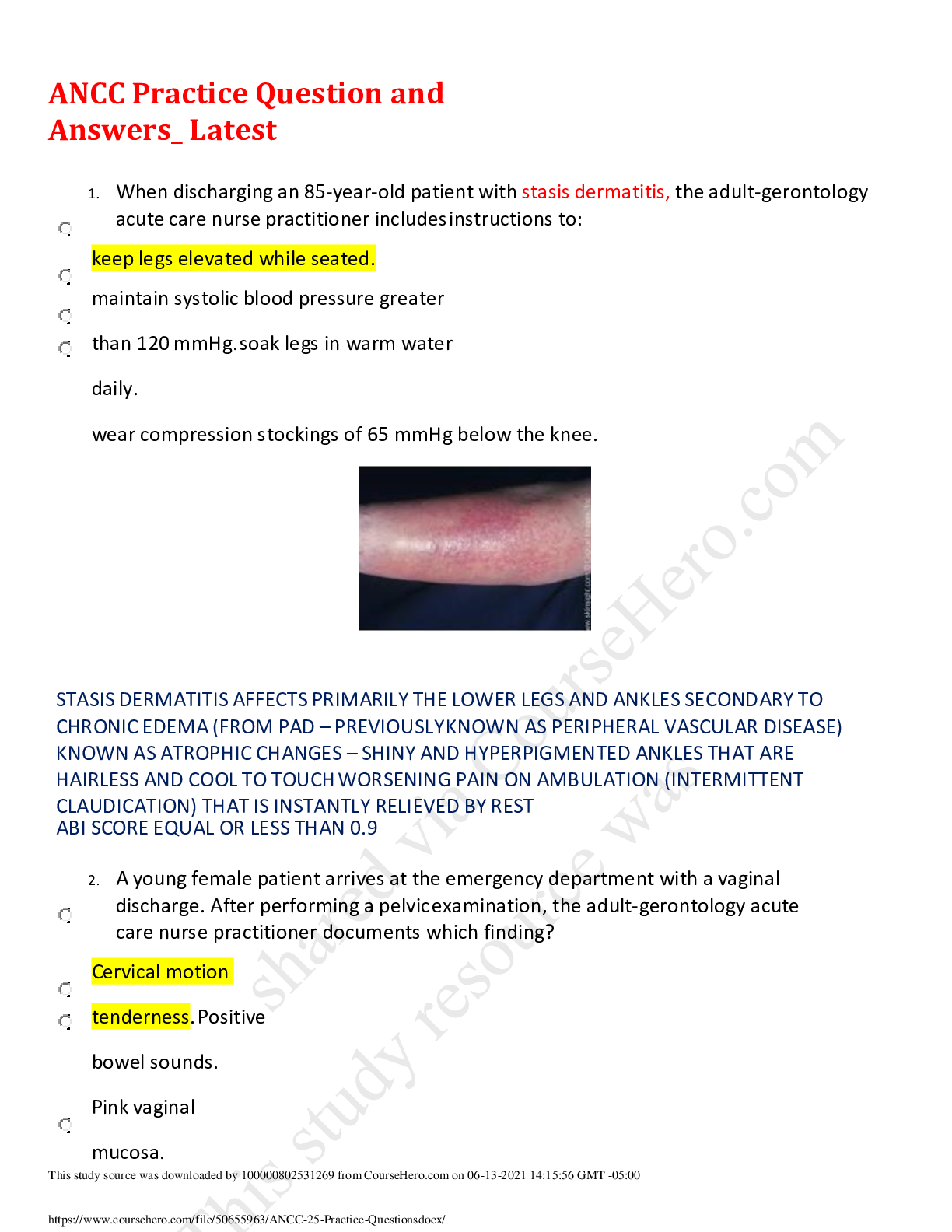
Buy this document to get the full access instantly
Instant Download Access after purchase
Add to cartInstant download
We Accept:

Reviews( 0 )
$16.00
Document information
Connected school, study & course
About the document
Uploaded On
Jun 13, 2021
Number of pages
12
Written in
Additional information
This document has been written for:
Uploaded
Jun 13, 2021
Downloads
0
Views
43














